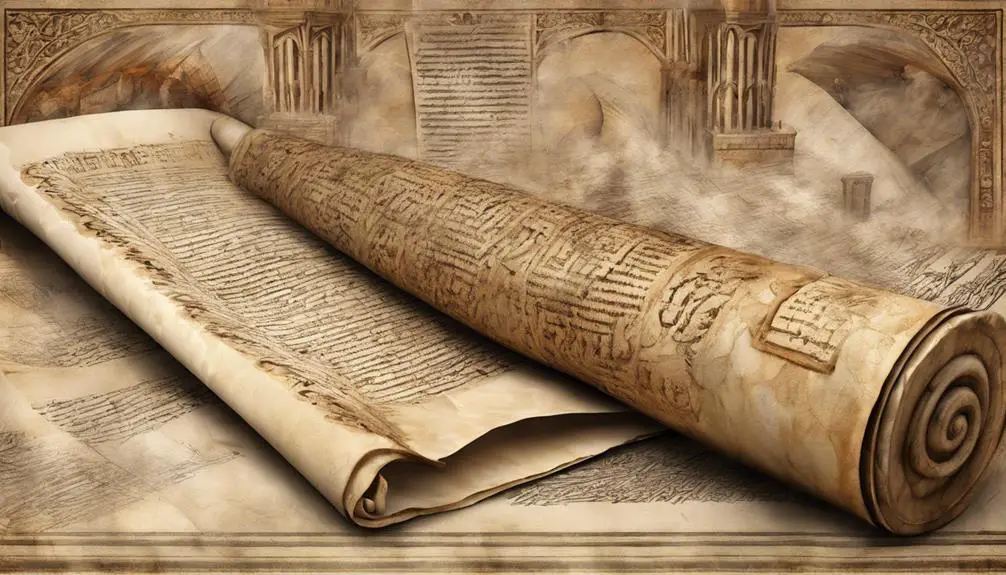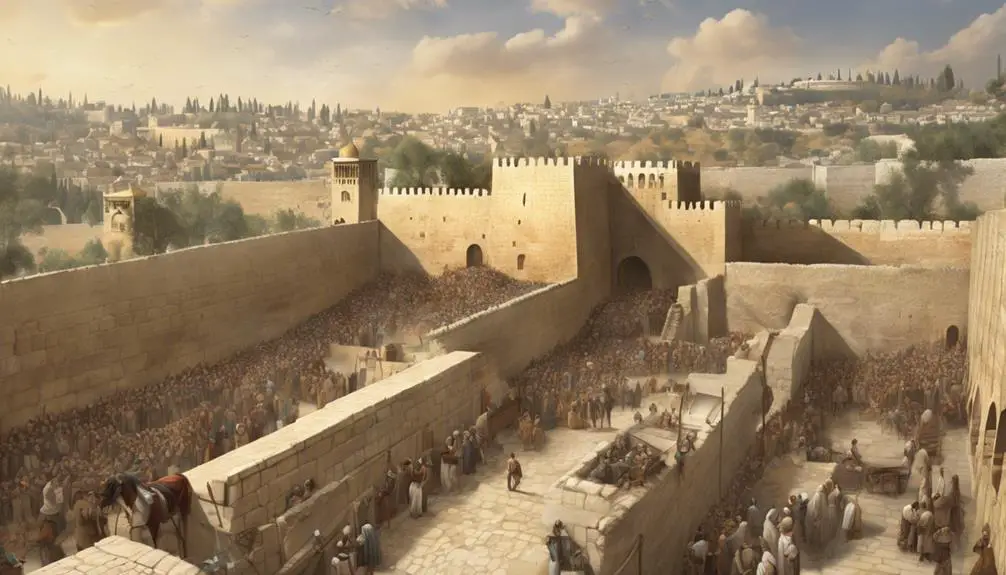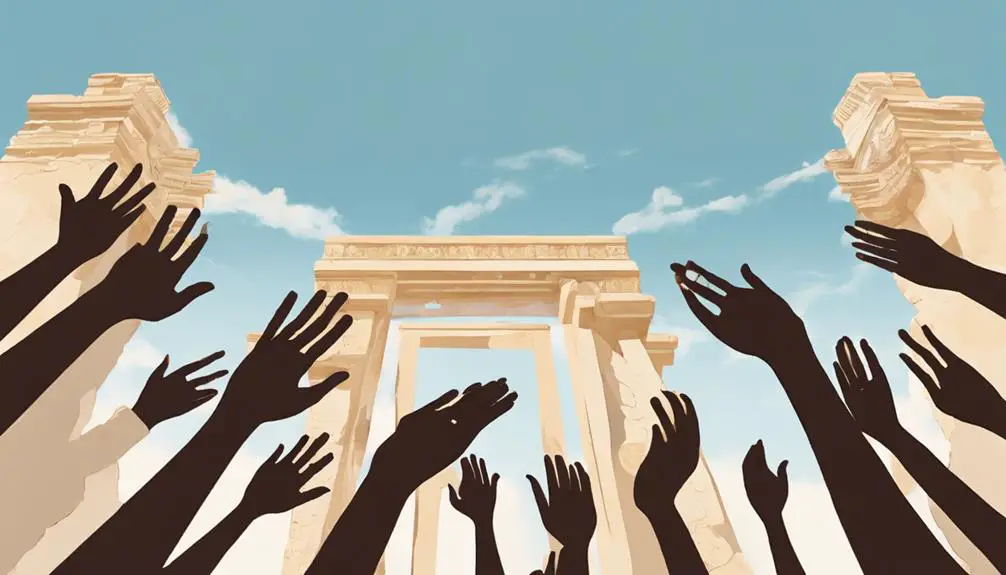Kneading through adversity, the book before Esther unveils timeless leadership lessons; dive in to uncover ancient wisdom.

Book Before Esther in the Bible
As the saying goes, 'Rome wasn't built in a day,' and neither were the walls of Jerusalem under Nehemiah's watchful guidance, which precedes the story of Esther in the Bible.
You'll find that Nehemiah's narrative isn't just a historical recount; it's a lesson in leadership, perseverance, and the power of community effort in the face of adversity.
If you're curious about how these themes play out in an ancient context and their relevance today, the book of Nehemiah offers intriguing insights.
Let's explore how the challenges he faced and the strategies he employed can inform modern leadership and community-building efforts.
Key Takeaways
- The book before Esther in the Bible is Nehemiah, focusing on Jerusalem's restoration and wall rebuilding.
- Nehemiah's leadership exemplifies strategic planning and patience under the Persian Empire's influence.
- The narrative underscores the importance of community collaboration and resilience in overcoming opposition.
- Nehemiah's legacy highlights the blend of faith, personal resilience, and visionary leadership in achieving lasting impact.
Nehemiah's Historical Context

Nehemiah, historically, often serves as a pivotal figure in understanding the post-exilic period of Judea, as he spearheaded the project of rebuilding Jerusalem's walls amidst significant opposition. His endeavor, deeply rooted in the socio-political milieu of the time, showcases the profound Persian influence on Judea, a direct consequence of Artaxerxes' decree. You'll find that this decree not only legitimized Nehemiah's mission but also reflected the broader geopolitical strategies of the Persian Empire, aiming to fortify its western provinces against potential threats.
Analyzing Nehemiah's actions and the subsequent rebuilding efforts, it's evident that the Persian influence extended beyond mere political support. It shaped the administrative structures, economic policies, and even religious practices in post-exilic Judea. The issuance of Artaxerxes' decree, a pivotal moment, underscores the complexities of Persian-Judean relations, revealing a nuanced layer of imperial diplomacy and local governance.
This historical moment, therefore, isn't just about a wall; it's a testament to the intricate dance of power, faith, and identity in a world where empires and emerging communities navigated their coexistence through both conflict and cooperation.
Leadership Lessons From Nehemiah
Reflecting on the historical context of Nehemiah's mission, it becomes apparent that his leadership offers invaluable insights for modern governance and personal development. Nehemiah exemplified strategic patience, a critical attribute that allowed him to navigate the complexities of rebuilding Jerusalem's walls amidst external opposition and internal discord. This patience wasn't passive; it was active and strategic, involving careful planning, timing, and the capacity to endure setbacks without losing sight of the ultimate goal.
Moreover, Nehemiah's ability to articulate his vision clearly and compellingly stands out. He didn't just have a plan; he'd the communication skills to inspire others to buy into that plan and work towards its realization. His vision articulation wasn't merely about the physical reconstruction of walls but about restoring a sense of community and identity among the Jewish people.
These lessons underscore the importance of leaders possessing not just technical skills or authority but the ability to patiently strategize and communicate a unifying vision. In contemporary leadership contexts, whether in politics, business, or community organizing, the principles of strategic patience and vision articulation that Nehemiah demonstrated can significantly influence success and resilience.
Community Rebuilding Efforts

In the wake of Nehemiah's strategic efforts, community rebuilding emerges as a critical follow-through, demanding a blend of resilience, collaboration, and visionary leadership to reforge communal bonds and infrastructure. You're tasked with navigating the complexities of urban renewal, where the physical reconstruction of walls and gates symbolizes a deeper process of social cohesion. This journey isn't merely architectural; it's about reweaving the social fabric of a community disrupted by exile and displacement.
Urban renewal, in this context, transcends the mere rebuilding of structures. It encapsulates efforts to restore a sense of belonging, identity, and security among the inhabitants. You'll find that fostering social cohesion is as paramount as the physical reconstruction, for without it, the community remains fragmented, vulnerable to both external threats and internal discord.
This phase of community rebuilding requires you to understand the multifaceted nature of human communities. Economic revival, social welfare, and spiritual renewal are all facets of this comprehensive effort. Moreover, integrating the returned exiles with those who remained presents a unique challenge, necessitating innovative approaches to ensure inclusivity and equity.
As you delve deeper, remember that the ultimate goal is to create a sustainable community where economic stability, social justice, and spiritual vitality coalesce, ensuring a resilient and cohesive society for generations to come.
Overcoming Opposition
Overcoming opposition is a critical step in the process of community rebuilding, as it requires a focused strategy to navigate the challenges posed by both internal disagreements and external threats. To effectively address these barriers, you'll need to employ strategic patience and personal resilience. These qualities aren't merely buzzwords but are essential tools in the intricate process of overcoming resistance to change.
Strategic patience allows you to carefully plan your moves, understanding that quick results may not always be possible. It's about playing the long game, recognizing that the path to rebuilding a community is fraught with setbacks and challenges that demand a steady, thoughtful approach. Personal resilience, on the other hand, is what keeps you steadfast in the face of adversity. It's the inner strength that enables you to bounce back from setbacks, maintaining focus on the overall goal despite the hurdles.
Incorporating these key elements into your strategy means you're not just reacting to opposition but are proactively preparing for it. You'll find that with strategic patience, you can better anticipate challenges and devise comprehensive solutions. Meanwhile, personal resilience ensures that you remain undeterred, transforming obstacles into stepping stones towards achieving your community rebuilding objectives.
Nehemiah's Legacy

Building on the foundation of strategic patience and personal resilience essential for overcoming opposition, Nehemiah's legacy offers a profound example of how these qualities can manifest in leadership and contribute to the successful rebuilding of a community. Central to this legacy is the emphasis on Nehemiah's prayers, which reflect not only a deep personal faith but also a reliance on spiritual guidance for the wisdom and strength necessary to undertake the monumental task of wall construction in Jerusalem. This aspect of his leadership underscores the importance of spiritual grounding in achieving tangible, material outcomes.
Moreover, the wall construction itself serves as a tangible symbol of Nehemiah's legacy, illustrating the power of collective action guided by visionary leadership. Nehemiah's ability to mobilize and inspire the people of Jerusalem, even in the face of significant external threats and internal dissent, showcases his exceptional skills in project management, diplomacy, and motivational leadership. His story is a testament to the fact that with the right blend of faith, strategic planning, and community engagement, formidable challenges can be overcome, leaving a lasting impact on the social and physical landscape of a community.
Frequently Asked Questions
Who Is the Author of the Book Preceding Esther in the Bible, and What Is Its Primary Genre?
You're diving into an authorship debate while exploring the genre of a specific text. Scholars haven't reached consensus on the author, attributing it to a range of figures from historical to mythical.
This exploration isn't just about who penned the words, but delves into the narrative's essence. It's considered historical literature, yet it's enriched with dramatic elements that challenge and engage.
This blend makes its classification uniquely complex, reflecting the multifaceted nature of ancient writings.
How Does the Theological Theme of the Book Before Esther Contrast With the Themes Found in Esther?
In a universe apart, where divine providence and human agency collide, you'll find the theological themes of Esther's predecessor starkly contrasting with Esther's narrative. While Esther highlights human agency in the absence of overt divine intervention, its precursor emphasizes divine providence guiding history's course.
You're diving into a world where the unseen hand shapes destinies, juxtaposed with Esther's tale, where human actions take center stage, revealing the multifaceted nature of faith and fate.
Can You Explain the Transition in Narrative Focus From the Book Before Esther to Esther Itself Within the Biblical Canon?
You're exploring the shift in narrative techniques and focus from royal succession to a more personal and communal survival story. This transition highlights a deepening in the narrative's complexity, weaving tales of power, identity, and resilience.
As you delve into Esther's story, you'll notice a marked departure from previous narratives, emphasizing individual agency within the broader context of survival and identity. This shift enriches the biblical canon with its unique storytelling approach.
What Are Some Key Prophetic or Messianic References, if Any, in the Book Preceding Esther, and How Do They Connect to the Broader Biblical Narrative?
You're diving into the exploration of messianic symbols and prophetic interpretations in a specific text. These elements are pivotal for understanding its connection to the broader biblical narrative.
By analyzing these references, you're uncovering layers of meaning that tie back to messianic expectations and prophetic visions throughout the scriptures.
This approach enriches your comprehension of the text's role within the tapestry of biblical prophecy and messianic anticipation.
How Does the Geographical Setting and Cultural Context of the Book Before Esther Differ From Those Depicted in the Book of Esther?
You're diving into how Persian politics and the Jewish diaspora shape a narrative, contrasting with Esther's setting.
While Esther unfolds in the Persian court, focusing on palace intrigue, the preceding story explores the broader implications of exile on Jewish identity and faith.
This earlier setting emphasizes the challenges and resilience within the Jewish diaspora, offering a detailed look at their struggle to maintain cultural and religious identity amidst foreign domination and political maneuvering.
Conclusion
In conclusion, Nehemiah's narrative serves as a masterclass in leadership, akin to a seasoned captain navigating treacherous waters. His journey, from the ruins to revitalization, illustrates the potency of unwavering determination and collective endeavor.
Amidst adversities, Nehemiah's legacy emerges as a beacon of hope, teaching us that the foundation of true leadership lies in the courage to rebuild, not just structures, but the very essence of community. Thus, Nehemiah's story transcends time, offering timeless lessons in resilience and unity.



Sign up